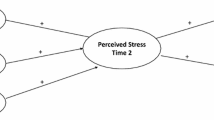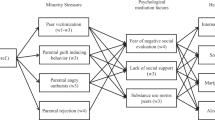Abstract
Background
In recent years, more than 5 million Venezuelans have left their once prosperous country, with several hundred thousand settling in the United States (US). At present, our understanding of the health risk behavior profiles of Venezuelan émigré youth, and their links with cultural stress, remains limited.
Objectives
Drawing from a sample of recently-immigrated Venezuelan youth in the US, we aim to identify subtypes of youth according to their involvement in health risk behaviors (i.e., substance use, sexual risk behavior, violence) and assess the associations between class membership and key constructs related to cultural stress theory (i.e., negative context of reception, family communication/support).
Method
Latent profile analysis and multinomial regression were performed using data from a community-based convenience sample of 402 recently-arrived Venezuelan immigrant youth (ages 10–17; 56% male).
Results
We identified five subtype classes: (1) “Abstainer” (36%), (2) “Alcohol Only” (24%), (3) “Alcohol/Tobacco” (24%), (4) “Aggression” (8%), and (5) “Multidimensional Risk” (8%). Compared to Class #1, youth in Classes #3 and #5 reported significantly higher levels of negative context of reception and lower levels of family functioning while controlling for demographic factors. Youth in Class #5 reported the lowest levels of family economic hardship and the longest duration in the US.
Conclusion
It is vital that we support both Venezuelan youth who abstain from risk behavior and, at the same time, develop and implement programs that target the needs of those who are at elevated risk for serious consequences related to substance use, sexual risk behavior, and violence.

Similar content being viewed by others
References
Organization of American States (2019) OAS Working Group to address the regional crisis caused by Venezuela’s migrant and refugee flows. Washington (DC): press and communications department, organization of American states. https://www.oas.org/en/media_center/press_release.asp?sCodigo=E-048/19. Accessed 19 Nov 2019
United Nations High Commissioner for Refugees (2019) Refugees and migrants from Venezuela top 4 million: UNHCR and IOM. United Nations High Commissioner for Refugees, Geneva (Accessed 2019 Nov 19)
Durand J, Massey DS (2010) New world orders: continuities and changes in Latin American migration. Ann Am Acad Pol Soc Sci 630(1):20–52. https://doi.org/10.1177/0002716210368102
Hanke S (2019) Venezuela’s hyperinflation hits 80,000% per year in 2018. Forbes. https://www.forbes.com/sites/stevehanke/2019/01/01/venezuelas-hyperinflation-hits-80000-per-year-in-2018/#4251e7aa4572. Accessed 19 Nov 2019
Taladrid S (2019) Venezeula’s food crisis reaches a breaking point. New Yorker. https://www.newyorker.com/news/news-desk/venezuelas-food-crisis-reaches-a-breaking-point. Accessed 19 Nov 2019
Salas-Wright CP, Vaughn MG, Cohen M, Schwartz SJ (2019) The sequelae of pre-migration hunger among Venezuelan immigrant children in the United States. Am J Prev Med 85(3):P467–469
Tuite AR, Thomas-Bachli A, Acosta H, Bhatia D, Huber C, Petrasek K, Watts A, Yong JH, Bogoch II, Khan K (2018) Infectious disease implications of large-scale migration of Venezuelan nationals. J Travel Med 25(1):tay077. https://doi.org/10.1093/jtm/tay077
United Nations Office on Drugs and Crime (2019) Intentional homicide victims. United Nations Office on Drugs and Crime, Vienna. https://dataunodc.un.org/crime/intentional-homicide-victims. (Accessed 2019 Nov 19)
Rawlins CG (2018) Venezuela: events of 2018. Human Rights Watch, New York. https://www.hrw.org/world-report/2019/country-chapters/venezuela. (Accessed 2019 Nov 19)
Datincorp (2016) Hallazgos relevantes del último Estudio de Coyuntura Venezuela de Datincorp sobre la “Toma de Caracas” el 1 de Septiembre/16. Datincorp, Caracas
Labrador RC (2019) The Venezuelan exodus. Council on Foreign Relations, New York. https://www.cfr.org/article/venezuelan-exodus. (Accessed 2019 Nov 19)
Troconis I, Stavans I (2018) Venezuelan Americans. Oxford Bibliographies, Oxford University Press, New York. https://www.oxfordbibliographies.com/view/document/obo-9780199913701/obo-9780199913701-0081.xml. (Accessed on 2019 Nov 19)
Noe-Bustamante L, Lopez MH (2019) Latin America, Caribbean no longer world’s fastest growing source of international migrants. Pew Research Center, Washington (DC). https://www.pewresearch.org/fact-tank/2019/01/25/latin-america-caribbean-no-longer-worlds-fastest-growing-source-of-international-migrants/. (Accessed 2019 Nov 19)
United States Citizenship and Immigration Services (2019) Asylum division quarterly stakeholder meeting. United States Citizenship and Immigration Services, Washington (DC). https://www.uscis.gov/outreach/asylum-division-quarterly-stakeholder-meeting-10. (Accessed 2019 Nov 19)
Henderson T (2018) Venezuelan immigrants get Trump sympathy but not status. https://www.pewtrusts.org/en/research-and-analysis/blogs/stateline/2018/10/02/venezuelan-immigrants-get-trump-sympathy-but-not-status. Accessed 23 Apr 2020
Robles F, Jordan M (2019) Venezuelans living in America watch crisis back home with hope and caution. https://www.nytimes.com/2019/01/24/us/venezuelans-florida-noticias-news.html. Accessed 23 Apr 2020
Hernandez AR (2020) Venezuelans seeking asylum present unique challenge to Trump administration. https://www.washingtonpost.com/immigration/trump-venezuela-asylum-border/2020/02/27/c9c827cc-54de-11ea-9e47-59804be1dcfb_story.html. Accessed 23 Apr 2020
Osorio S (2019) They fled a nightmare in Venezuela, only to wind up in U.S. immigration prisons. https://www.miamiherald.com/news/nation-world/world/americas/venezuela/article238072964.html. Accessed 23 Apr 2020
UNHCR Venezuela situation. https://www.unhcr.org/en-us/venezuela-emergency.html. Accessed 23 Apr 2020
Schwartz SJ, Salas-Wright CP, Pérez-Gómez A, Mejía-Trujillo J, Brown EC, Montero-Zamora P, Meca A, Scaramutti C, Soares MH, Vos SR, Javakhishvili N (2018) Cultural stress and psychological symptoms in recent Venezuelan immigrants to the United States and Colombia. Int J Intercult Relat 67:25–34. https://doi.org/10.1016/j.ijintrel.2018.09.001
Gallardo LH, Bataova J (2020) Venezuelan immigrants in the United States. https://www.migrationpolicy.org/article/venezuelan-immigrants-united-states. Accessed 23 Apr 2020
Felter C, Renwick D (2019) The U.S. immigration debate. Council on Foreign Relations, New York. https://www.cfr.org/backgrounder/us-immigration-debate-0. Accessed 19 Nov 2019
Almeida J, Biello KB, Pedraza F, Wintner S, Viruell-Fuentes E (2016) The association between anti-immigrant policies and perceived discrimination among Latinos in the US: a multilevel analysis. SSM Popul Health 2:897–903. https://doi.org/10.1016/j.ssmph.2016.11.003
Salas-Wright CP, Schwartz SJ (2019) The study and prevention of alcohol and other drug misuse among migrants: toward a transnational theory of cultural stress. Int J Ment Health Addict 17(2):346–369. https://doi.org/10.1007/s11469-018-0023-5
Cano MÁ, Schwartz SJ, Castillo LG, Romero AJ, Huang S, Lorenzo-Blanco EI, Unger JB, Zamboanga BL, Des Rosiers SE, Baezconde-Garbanati L, Lizzi KM (2015) Depressive symptoms and externalizing behaviors among Hispanic immigrant adolescents: examining longitudinal effects of cultural stress. J Adolesc 42:31–39. https://doi.org/10.1016/j.adolescence.2015.03.017
Lorenzo-Blanco EI, Meca A, Unger JB, Romero A, Gonzales-Backen M, Piña-Watson B, Cano MÁ, Zamboanga BL, Des Rosiers SE, Soto DW, Villamar JA (2016) Latino parent acculturation stress: longitudinal effects on family functioning and youth emotional and behavioral health. J Fam Psychol 30(8):966. https://doi.org/10.1037/fam0000223
Schwartz SJ, Mason CA, Pantin H, Szapocznik J (2009) Longitudinal relationships between family functioning and identity development in Hispanic adolescents: continuity and change. J Early Adolesc 29(2):177–211. https://doi.org/10.1177/0272431608317605
Salas-Wright CP, Vaughn MG, Goings TC, Oh S, Marsiglia F, Cohen M, John R, Andrad P, Schwartz S (2020) Disconcerting levels of alcohol use among Venezuelan immigrant adolescents in the United States. Addictive behaviors 104:106269
Vaughn MG, Salas-Wright CP, DeLisi M, Maynard BR (2014) Violence and externalizing behavior among youth in the United States: is there a severe 5%? Youth Violence Juv Justice 12(1):3–21. https://doi.org/10.1177/1541204013478973
Córdova D, Heinze JE, Hsieh HF, Mistry R, Salas-Wright CP, Cook SH, Zimmerman MA (2018) Are trajectories of a syndemic index in adolescence linked to HIV vulnerability in emerging and young adulthood? An eighteen-year longitudinal study. AIDS 32(4):495–503. https://doi.org/10.1097/qad.0000000000001717
Salas-Wright CP, Olate R, Vaughn MG (2015) Substance use, violence, and HIV risk behavior in El Salvador and the United States: cross-national profiles of the SAVA syndemic. Vict Offender 10(1):95–116. https://doi.org/10.1080/15564886.2014/940435
Singer M, Clair S (2003) Syndemics and public health: reconceptualizing disease in bio-social context. Med Anthropol Q 17(4):423–441. https://doi.org/10.1525/maq.2003.17.4.423
Coffman DL, Patrick ME, Palen LA, Rhoades BL, Ventura AK (2007) Why do high school seniors drink? Implications for a targeted approach to intervention. Prev Sci 8(4):241–248. https://doi.org/10.1007/s11121-007-0078-1
Sousa VD, Rojjanasrirat W (2011) Translation, adaptation and validation of instruments or scales for use in cross-cultural health care research: a clear and user-friendly guideline. J Eval Clin Pract 17(2):268–274. https://doi.org/10.1111/j.1365-2753.2010.01434.x
Schwartz SJ, Unger JB, Lorenzo-Blanco EI, Des Rosiers SE, Villamar JA, Soto DW, Pattarroyo M, Baezconde-Garbanati L, Szapocznik J (2014) Perceived context of reception among recent Hispanic immigrants: conceptualization, instrument development, and preliminary validation. Cult Divers Ethn Minor Psychol 20(1):1. https://doi.org/10.1037/a0033391
Lasky P, Buckwalter KC, Whall A, Lederman R, Speer J, McLane A, King JM, White MA, Woods NF, Rees BL (1985) Developing an instrument for the assessment of family dynamics. West J Nurs Res 7(1):40–57. https://doi.org/10.1177/0092055x8500700105
Zimet GD, Dahlem NW, Zimet SG, Farley GK (1988) The multidimensional scale of perceived social support. J Pers Assess 52(1):30–41. https://doi.org/10.1207/s15327752jpa5201_2
McLachlan G, Peel D (2000) Finite mixture models. New York: John Wiley & Sons, Inc.
Long JS, Freese J (2006) Regression models for categorical dependent variables using Stata. Stata Press, College Park
Vermunt JK, Magidson J (2015) Upgrade manual for latent GOLD 5.1. Statistical Innovations, Belmont
Celeux G, Soromenho G (1996) An entropy criterion for assessing the number of clusters in a mixture model. J Classif 13(2):195–212. https://doi.org/10.1007/bf01246098
Muthén LK, Muthén BO (2007) Re: what is a good value of entropy? [Online comment]. Mplus, Los Angeles. https://www.statmodel.com/discussion/messages/13/2562.html. (Accessed 19 Nov 2019)
Zhang J, Kai FY (1998) What’s the relative risk?: a method of correcting the odds ratio in cohort studies of common outcomes. JAMA 280(19):1690–1691. https://doi.org/10.1001/jama.280.191690
Vaughn MG, Nelson EJ, Oh S, Salas-Wright CP, DeLisi M, Holzer KJ (2018) Abstention from drug use and delinquency increasing among youth in the United States, 2002–2014. Subst Use Misuse 53(9):1468–1481. https://doi.org/10.1080/10826084.2017.1413392
Piquero AR, Brezina T, Turner MG (2005) Testing Moffitt’s account of delinquency abstention. J Res Crime Delinq 42(1):27–54
Vaughn MG, Fu Q, Wernet SJ, DeLisi M, Beaver KM, Perron BE, Howard MO (2011) Characteristics of abstainers from substance use and antisocial behavior in the United States. J Crim Justice 39(3):212–217. https://doi.org/10.1016/j.jcrimjus.2011.02.003
Centers for Disease Control and Prevention (2017) United States, high school youth risk behavior survey, 2017. Centers for Disease Control and Prevention, Atlanta. https://nccd.cdc.gov/Youthonline/App/Results.aspx?LID=XX. (Accessed 2019 Nov 19)
Salas-Wright CP, AbiNader MA, Vaughn MG, Sanchez M, De La Rosa M (2019) Trends in participation in teen pregnancy and STI prevention programming, 2002–2016. Prev Med 126:105753. https://doi.org/10.1016/j.ypmed.2019.105753
Oh S, Gonzalez JM, Salas-Wright CP, Vaughn MG, DiNitto DM (2017) Prevalence and correlates of alcohol and tobacco use among pregnant women in the United States: evidence from the NSDUH 2005–2014. Prev Med 97:93–99. https://doi.org/10.1016/j.ypmed.2017.01.006
Salas-Wright CP, Vaughn MG, Ugalde J, Todic J (2015) Substance use and teen pregnancy in the United States: evidence from the NSDUH 2002–2012. Addict Behav 45:218–225. https://doi.org/10.1016/j.addbeh.2015.01.039
Salas-Wright CP, Vaughn MG, Schwartz SJ, Córdova D (2016) An, “immigrant paradox” for adolescent externalizing behavior? Evidence from a national sample. Soc Psychiatry Psychiatr Epidemiol 51(1):27–37. https://doi.org/10.1007/s00127-015-1115-1
Vaughn MG, Maynard BR, Salas-Wright CP, DeLisi M (2018) The severe 5% and psychopathy. In: DeLisi M (eds) Routledge international handbook of psychopathy and crime. Routledge, New York. pp 526–543. https://doi.org/10.4324/9781315111476-34
Salas-Wright CP, Hernandez L, Maynard RB, Saltzman YL, Vaughn MG (2014) Alcohol use among Hispanic early adolescents in the United States: an examination of behavioral risk and protective profiles. Subst Use Misuse 49(7):864–877. https://doi.org/10.3109/10826084.2014/880725
Salas-Wright CP, Vaughn MG, González JM (2017) Drug abuse and antisocial behavior: a biosocial life course approach. Springer, New York
Pan American Health Organization (2015) Harmful alcohol use is increasing in the Americas. World Health Organization, Washington (DC). https://www.paho.org/hq/index.php?option=com_content&view=article&id=11116:2015-harmful-alcohol-use-increasing-americas&Itemid=135&lang=en. (Accessed 2019 Nov 19)
Sudhinaraset M, Wigglesworth C, Takeuchi DT (2016) Social and cultural contexts of alcohol use: Influences in a social–ecological framework. Alcohol Res 38(1):35–45
Funding
Funding was provided by National Institute on Drug Abuse (Grant no: DA030310) and National Institute on Alcohol Abuse and Alcoholism (Grant no: K01 AA026645).
Author information
Authors and Affiliations
Corresponding author
Ethics declarations
Conflict of interest
The authors have no conflict to disclose.
Ethical statement
Research reported in this publication was supported by the National Institute on Drug Abuse of the National Institutes of Health under Award Number DA030310. The content is solely the responsibility of the authors and does not necessarily represent the official views of the National Institutes of Health.
Rights and permissions
About this article
Cite this article
Salas-Wright, C.P., Goings, T.C., Vaughn, M.G. et al. Health risk behavior and cultural stress among Venezuelan youth: a person centered approach. Soc Psychiatry Psychiatr Epidemiol 56, 219–228 (2021). https://doi.org/10.1007/s00127-020-01905-w
Received:
Accepted:
Published:
Issue Date:
DOI: https://doi.org/10.1007/s00127-020-01905-w




